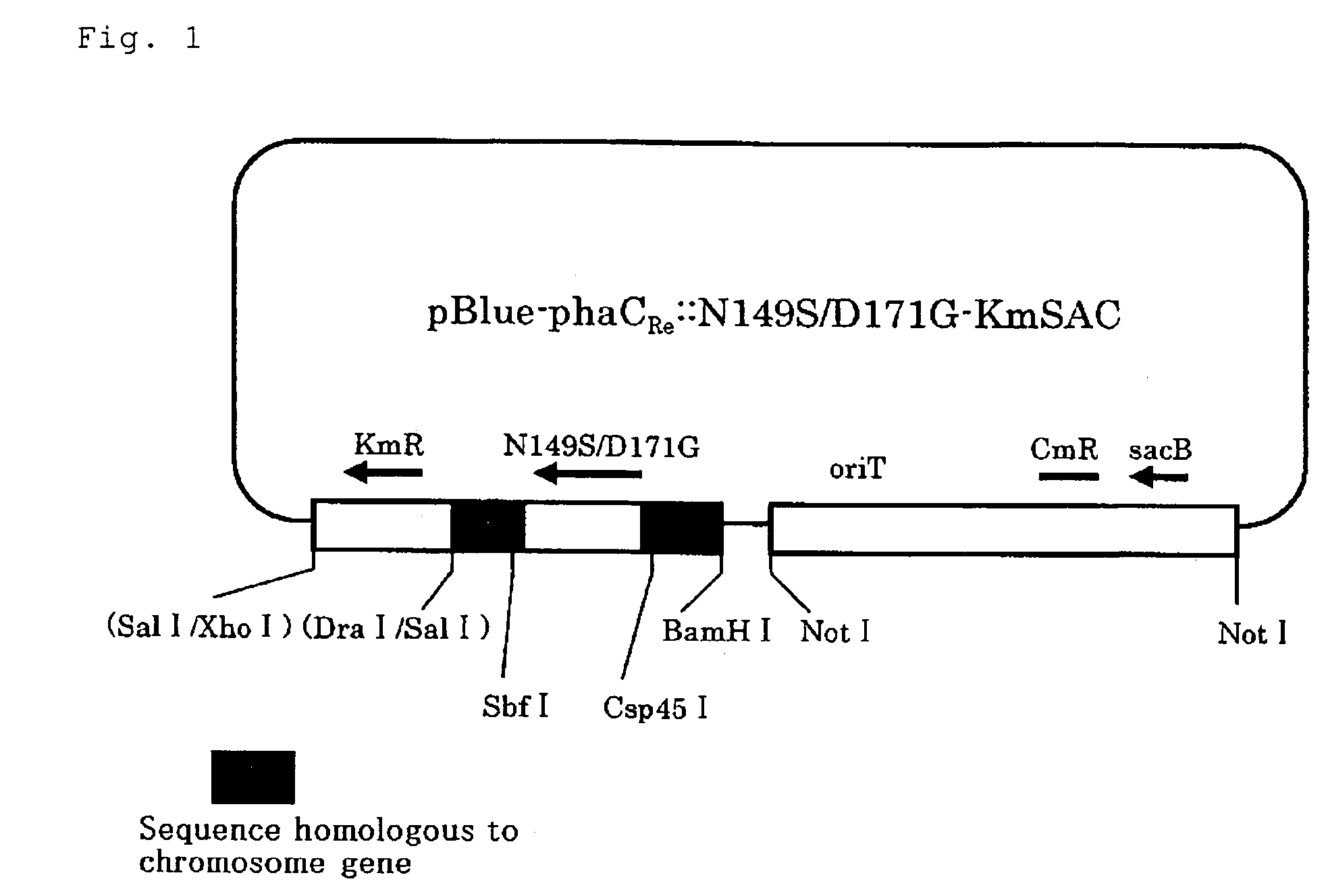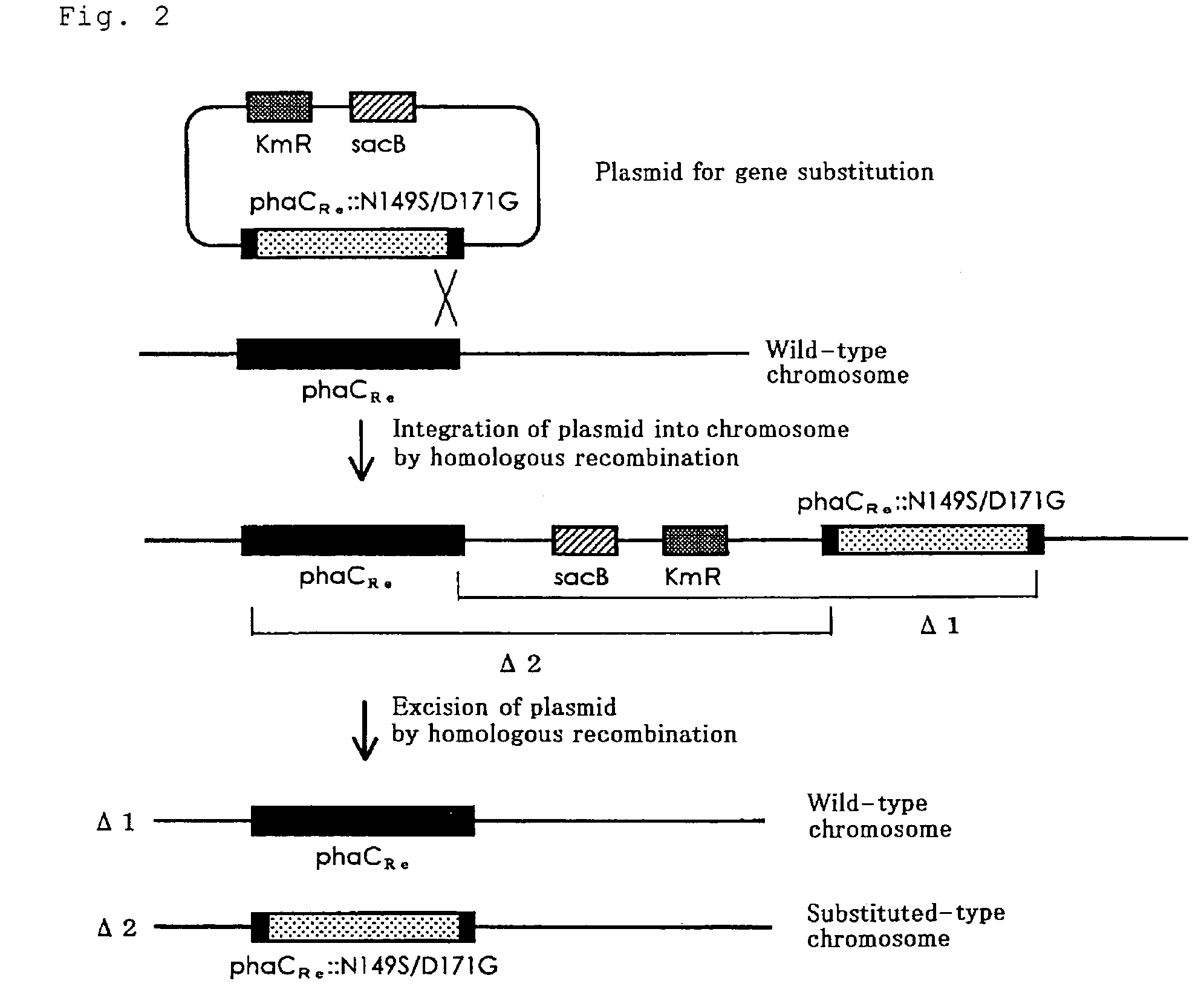Gene-substituted microorganisms, and production method of polyesters using the same
a technology of gene substitution and microorganisms, which is applied in the field of gene substitution and polyester production methods, can solve the problems of limited practical application range, low polyester productivity, and inability to improve flexibility
- Summary
- Abstract
- Description
- Claims
- Application Information
AI Technical Summary
Benefits of technology
Problems solved by technology
Method used
Image
Examples
example 1
Construction of a Plasmid for Gene Substitution
[0073]A PCR reaction was carried out using cells of a Ralstonia eutropha H16 strain as a supply source of a template DNA and using primers as shown under SEQ ID NO:1 and NO:2, and a DNA fragment containing a structural gene of polyhydroxyalkanoic acid synthase gene (phaCRe) was obtained. The PCR reaction conditions were as follows: (1) at 94° C. for 2 minutes, (2) at 94° C. for 30 seconds, (3) at 45° C. for 30 seconds, (4) at 72° C. for 3 minutes, 25 cycles of (2) to (4), and (5) at 72° C. for 5 minutes. As a polymerase, TaKaRa LA Taq (product of TAKARA BIO INC.) was used. The DNA fragment obtained by PCR was cleaved with the restriction enzyme BamHI, and subcloned into the vector pBluescriptIIKS (−) (product of TOYOBO CO., LTD.) at the site which had already been cleaved with BamHI (pBlue-phaCRe).
[0074]N149S / D171G mutant, which is a polyester synthase mutant gene derived from Aeromonas caviae, was produced as follows. First, pBluescrip...
example 2
Construction of a Gene-substituted Strain
[0079]An Escherichia coli S17-1 strain (ATCC47005) was transformed with the plasmid for gene substitution pBlue-phaCRe::N149S / D171G-KmSAC, and subjected to mixed culture with a Ralstonia eutropha H16 strain on Nutrient Agar medium (product of DIFCO Laboratories) to carry out conjugal transfer. A strain grown on Simmons agar medium containing 250 mg / L of kanamycin (sodium citrate 2 g / L, sodium chloride 5 g / L, magnesium sulfate-heptahydrate 0.2 g / L, ammonium dihydrogenphosphate 1 g / L, dipotassium hydrogenphosphate 1 g / L, agar 15 g / L, pH 6.8) was selected, and a strain in which the plasmid is incorporated onto the chromosome of the Ralstonia eutropha H 16 strain was obtained (homologous recombination of the first stage). This strain was cultured on Nutrient Broth medium (product of DIFCO Laboratories) through two generations, and diluted and applied on Nutrient Agar medium containing 15% of sucrose. Grown strains were selected to obtain the stra...
example 3
Production and Purification of Polyester
[0081]The composition of a seed culture medium was set as follows: 1 w / v % Meat-extract, 1 w / v % Bacto-Trypton, 0.2 w / v % Yeast-extract, 0.9 w / v % Na2PO4.12H2O, 0.15 w / v % KH2PO4, and pH 6.8.
[0082]The composition of a preculture medium was set as follows: 1.1 w / v % of Na2PO4.12H2O, 0.19 w / v % of KH2PO4, 1.29 w / v % of (NH4)2SO4, 0.1 w / v % of MgSO4.7H2O, 2.5 w / v % of palm W oleic oil, and 0.5 v / v % of solution containing trace amount of a metal salt (prepared by dissolving 1.6 w / v % of FeCl3.6H2O, 1 w / v % of CaCl2.2H2O, 0.02 w / v % of CoCl2.6H2O, 0.016 w / v % of CuSO4.5H2O, and 0.012 w / v % of NiCl2.6H2O in 0.1 N hydrochloric acid).
[0083]The composition of a polyester-producing medium was set as follows: 0.385 w / v % of Na2PO4.12H2O, 0.067 w / v % of KH2PO4, 0.291 w / v % of (NH4)2SO4, 0.1 w / v % of MgSO4.7H2O, 0.5 v / v % of solution containing trace amount of a metal salt (prepared by dissolving 1.6 w / v % of FeCl3.6H2O, 1 w / v % of CaCl2.2H2O, 0.02 w / v % ...
PUM
| Property | Measurement | Unit |
|---|---|---|
| temperature | aaaaa | aaaaa |
| pH | aaaaa | aaaaa |
| weight | aaaaa | aaaaa |
Abstract
Description
Claims
Application Information
 Login to View More
Login to View More - R&D
- Intellectual Property
- Life Sciences
- Materials
- Tech Scout
- Unparalleled Data Quality
- Higher Quality Content
- 60% Fewer Hallucinations
Browse by: Latest US Patents, China's latest patents, Technical Efficacy Thesaurus, Application Domain, Technology Topic, Popular Technical Reports.
© 2025 PatSnap. All rights reserved.Legal|Privacy policy|Modern Slavery Act Transparency Statement|Sitemap|About US| Contact US: help@patsnap.com



